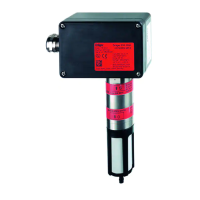9
Installing the Gas Transmitter
— The leads between central device and gas transmitter must have a sufficiently
low resistance to ensure the correct supply voltage at the gas transmitter. The
maximum resistance per core is calculated as follows:
Example: With U
C
= 24 V, the result is a maximum resistance per core of R = 35 Ω.
— The maximum resistance of the loop R
I
(sum of the internal resistance of the
central device and of the cable resistance of the signal line) depends on the
transmitter supply voltage as described below:
When used according to BVS 05 ATEX E 143 X, please note:
After attachment of the sensor to a casing with the type of protection increased
safety "e", the air gaps and creepage distances must comply with the
requirements specified in 4.3 (Table 1) or 4.4 of EN 60079-7. The single core
cables must be routed and connected in a way that is mechanically protected
and complies with the temperature resistance of the wires as specified in 4.5,
4.7.2 and 4.8 of EN 60079-7.
From an electrostatic point of view (transition resistance < 10
6
ohm) the sensor
casing must be conductively connected to the equipotential bonding of the
casing to which it is attached as soon at it is attached. If equipotential bonding is
required, it must be provided with the attachment.
R = 2.5 x U
C
– 25
with R: maximum resistance per core
U
C
: voltage supplied by central device in volts (usually depends on the
supply voltage of the central device)
NOTICE
Cable resistance deviations caused by temperature influences, transition
resistances of terminals, etc. can also contribute to the fact that the calculated
cable length can not be fully used.
Supply voltage at
the transmitter
maximum resistance of
the loop R
I
10 V 200 Ω
12 V 300 Ω
14 V 390 Ω
16 V 480 Ω

